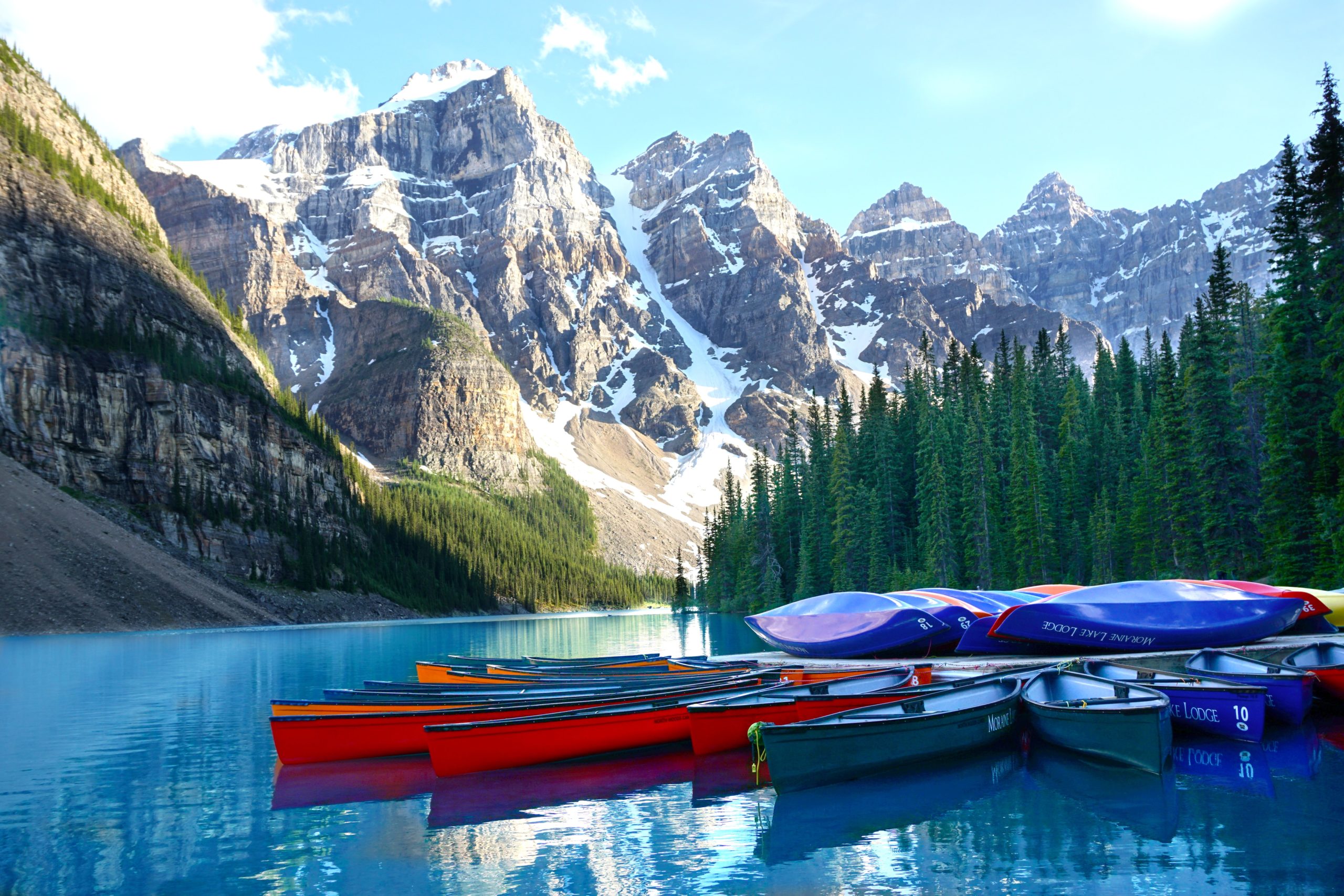3
Origins of Tourism in Canada
Tourism has long been a source of economic development for our country. Some argue that as early as 1534 the explorers of the day, such as Jacques Cartier, were Canada’s first tourists (Dawson, 2004), but most agree the major developments in Canada’s tourism industry followed milestones in the transportation sector: by rail, by car, and eventually, in the skies.
An accessible version of this activity is provided in the back matter of the book: Origins of Tourism in Canada Timeline
Railway Travel: The Ties That Bind

The dawn of the railway age in Canada came midway through the 19th century. The first railway was launched in 1836 (Library and Archives Canada, n.d.), and by the onset of World War I in 1914, four railways dominated the Canadian landscape: Canadian Pacific Railway (CPR), Canadian Northern Railway (CNOR), the Grand Trunk Railway (GTR), and the Grand Trunk Pacific (GTP). Unfortunately, their rapid expansion soon brought the last three into near bankruptcy (Library and Archives Canada, n.d.).
In 1923, these three rail companies were amalgamated into the Canadian National Railway (CNR), and together with the CPR, these trans-continentals dominated the Canadian travel landscape until other forms of transportation became more popular. In 1978, with declining interest in rail travel, the CPR and CNR were forced to combine their passenger services to form VIA Rail (Library and Archives Canada, n.d.).
The Rise of the Automobile
The rising popularity of car travel was partially to blame for the decline in rail travel, although it took time to develop. When the first cross-country road trip took place in 1912, there were only 16 kilometres of paved road across Canada (MacEachern, 2012). Cars were initially considered a nuisance, and the National Parks Branch banned entry of automobiles, but later slowly began to embrace them. By the 1930s, some parks, such as Cape Breton Highlands National Park, were actually created to provide visitors with scenic drives (MacEachern, 2012).
It would take decades before a coast-to-coast highway was created, with the Trans-Canada Highway officially opening in Revelstoke in 1962. When it was fully completed in 1970, it was the longest national highway in the world, spanning one-fifth of the globe (MacEachern, 2012).
Early Tourism Promotion
As early as 1892, enterprising Canadians like the Brewsters became the country’s first tour operators, leading guests through areas such as Banff National Park (Brewster Travel Canada, 2014). Communities across Canada developed their own marketing strategies as transportation development took hold. For instance, the town of Maisonneuve in Quebec launched a campaign from 1907 to 1915 calling itself “Le Pittsburg du Canada.” By 1935, Quebec was spending $250,000 promoting tourism. Other provinces such as Ontario, New Brunswick, and Nova Scotia followed suit, also enjoying the benefits of establishing provincial tourism bureaus (Dawson, 2004).
National Airlines
Our national airline, Air Canada, was formed in 1937 as Trans-Canada Air Lines. In many ways, Air Canada was a world leader in passenger aviation, introducing the world’s first computerized reservations system in 1963 (Globe and Mail, 2014). Through the 1950s and 1960s, reduced airfares saw increased mass travel. Competitors including Canadian Pacific (which became Canadian Airlines in 1987) began to launch international flights during this time to Australia, Japan, and South America (Canadian Geographic, 2000). By 2000, Air Canada was facing financial peril and forced to restructure. A numbered company, owned in part by Air Canada, purchased 82% of Canadian Airline’s shares, with the result of Air Canada becoming the country’s only national airline (Canadian Geographic, 2000). The 2000s saw Air Canada experiencing a roller-coaster performance from verging near bankruptcy in 2002, to reorganizations and fleet modernizations up to 2007, and another downturn due to the global recession in 2008 (ACE Aviation, 2011; Air Canada, 2007; CBC News, 2009). Air Canada experienced a number of transformations from interior and interior aircraft redesigns and further fleet upgrades from 2013 to 2017 (Air Canada, 2016). Once a rival airline, Air Transat was subsequently taken over by Air Canada in 2019 (CBC News, 2019). The near halt of the global tourism industry during the pandemic of COVID-19 in 2020 severely affected Air Canada, which posted a whopping $1 billion loss in its first quarter, cutting thousands of jobs, slashing 90% of its flight schedule, and foreseeing a tough and later rebound (Reynolds, 2020).
Parks and Protected Areas
A look at the evolution of tourism in Canada would be incomplete without a quick study of our national parks and protected areas. The official conservation of our natural spaces began around the same time as the railway boom, and in 1885 Banff was established as Canada’s first national park. By 1911, the Dominion Forest Reserves and Parks Act created the Dominion Parks Branch, the first of its kind in the world (Shoalts, 2011).

The systemic conservation and celebration of Canada’s parks over the next century would help shape Canada’s identity, both at home and abroad. Through the 1930s, conservation officers and interpreters were hired to enhance visitor experiences. By 1970, the National Park System Plan divided Canada into 39 regions, with the goal of preserving each distinct ecosystem for future generations. In 1987, the country’s first national marine park was established in Ontario, and in the 20 years that followed, 10 new national parks and marine conservation areas were created (Shoalts, 2011).
The role of parks and protected areas in tourism is explored in greater detail in Chapter 5 (Recreation) and Chapter 10 (Environmental Stewardship).
Global Shock and Industry Decline
As with the global industry, Canada’s tourism industry was impacted by world events such as the Great Depression, the World Wars, socio-political turmoil, and global outbreak of disease.
Global events such as 9/11, the SARS outbreak, the wars in Afghanistan and Iraq, and the economic recession of 2008 took their toll on tourism receipts but have successfully seen short-term rebounds. However, nothing has been more impactful to the tourism industry as the corona virus of 2019 (COVID-19), which was first found in China in late 2019 and eventually declared as a pandemic by March 2020 as it spread globally. Tourism was placed in a standstill as global travel restrictions were imposed to prevent the spread of infection. Aggravated with a nose dive of consumer confidence in travel, many tourism businesses and operators big and small were forced to close. The UNWTO predicted a 60% to 70% drop in tourist numbers, as well as a loss of a staggering USD 910 billion to USD 1.2 trillion in export revenues, and up to 120 million jobs put at risk (UNWTO, 2020b). According to the UNWTO (2020b), COVID-19 created the worst crisis in the history of global tourism since records began in 1950.

Tourism in Canada Prior to COVID-19
In 2018, tourism created $102 billion in total economic activity and 1.8 million jobs according to the Tourism Industry Association of Canada (2018a). Up to 2019, Canadian tourism reached its 3rd consecutive year of breaking records by welcoming 22.1 million inbound visitors (TIAC, 2020). Tourism is a major player in the workforce, where 1 in 11 jobs in the country is directly involved with travellers, as stated by TIAC (2018a).
Spotlight On: The Tourism Industry Association of Canada (TIAC)
Founded in 1930 and based in Ottawa, the Tourism Industry Association of Canada (TIAC) is the national private-sector advocate for the industry. Its goal is to support policies and programs that help the industry grow, while representing over 400 members including airports, concert halls, festivals and events, travel services providers, and businesses of all sizes. For more information, visit the Tourism Industry Association of Canada’s website.
The United States is Canada’s biggest tourism market, which we welcome more than all international travellers combined. Thanks to our immediate proximity, open borders, and ease of travel, we are actually both each other’s top market. As 68% of all inbound visitors to Canada in 2018, American travellers are also big spenders at $663 per trip and typically seek natural attractions, historical sites, and food and drink when they enter the country (TIAC, 2018b).
Aside from the United States, Canada continues to see strong visitation from the United Kingdom, France, Mexico, Brazil, and China. In 2018, we welcomed 6.9 million travellers (excluding the US), more that doubling since 2011 (Statistics Canada, 2019). Canadians travelling domestically accounted for 78% of tourism revenues in the country, though spend less at $244 per trip (TIAC, 2018c).
Spotlight On: Destination Canada
Housed in Vancouver, Destination Canada, previously the Canadian Tourism Commission (CTC), is responsible for promoting Canada as a tourist destination both within Canada itself and to and to several foreign markets. Currently focused on ten international core markets for international marketing: Australia, China, France, Germany, India, Japan, Mexico, South Korea, the United Kingdom, and the United States. Destination Canada also is responsible for proving intelligence, tools and resources to support Canada’s tourism industry from coast to coast. Lastly, Destination Canada works with private companies, travel services providers, meeting professionals, and government organizations to help leverage Canada’s tourism brand, For Glowing Hearts. For more information, visit the Destination Canada corporate website and Destination Canada’s traveler website.
As organizations like TIAC work to confront barriers to travel, Destination Canada is active abroad, encouraging more visitors to explore our country. In Chapter 8, we’ll delve more into the challenges and triumphs of selling tourism at home and abroad.
The great news for British Columbia is that once in Canada, most international visitors tend to remain in the province they landed in, and BC is one of three provinces that receives the bulk of this traffic (Destination Canada, 2019). In fact, BC’s tourism industry is one of the healthiest in Canada today. Let’s have a look at how our provincial industry was established and where it stands now.
Media Attributions
- Canadian Pacific 4-4-0 A-2-m No 136 by Peter Broster is licensed under a CC BY 2.0 Licence.
- Moraine Lake, Canada by Matthew Fournier is licenced under the Unspash Licence.
- Marina Bay, Singapore by Victor He is licenced under the Unspash Licence.

